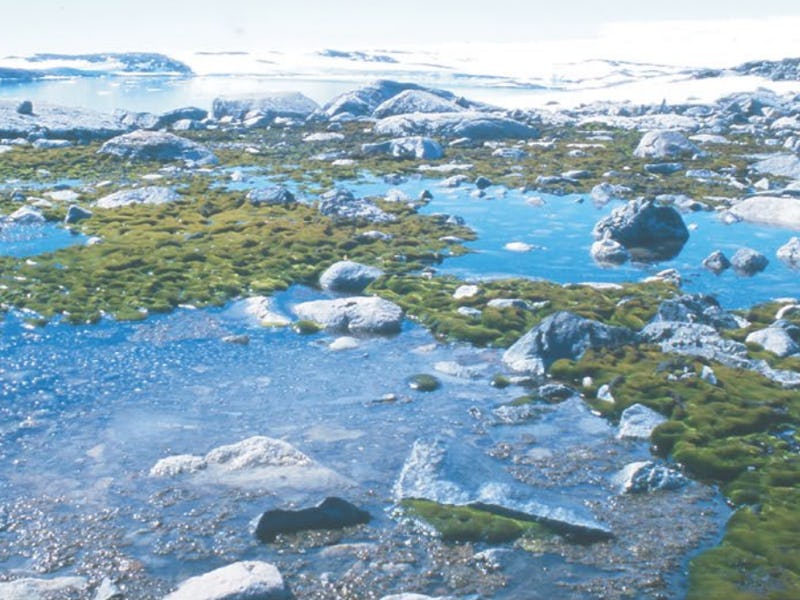Antarctica's Rapidly Changing Plants Reveal New Frontier of Climate Change
Yes, Antarctica has plants. No, they're not doing well.

Despite what we think we know about Antarctica, it’s not all snow and ice. The largely frozen continent has a very short summer, which brings ice melts that flood the land, allowing important mosses and lichens to grow. New research published in the journal Nature Climate Change, however, shows that the plant life in East Antarctica’s Windmill Islands is rapidly changing in response to some seemingly unusual effects of climate change. Though we usually associate a warming climate with melting ice, the paper shows that parts of East Antarctica are actually drying up.
Much of the research on warming in the region has focused on West Antarctica and the Antarctic Peninsula, but this is one of the first to show how East Antarctica’s terrestrial ecosystem is being affected too. In the paper published Monday, the international team shows how conspicuously Antarctica’s plant life has changed from 2000 to 2013. Tracking two old-growth moss beds in East Antarctica, the researchers found several significant changes: For instance, there was far less of the Antarctic moss Schistidium antarctici in 2008 to 2013 than there had been at the beginning of the study period. In one portion of the area, it declined by almost 94 percent.
This moss isn’t the only species the team is worried about. “Our data suggest that climate change and ozone depletion are already impacting old-growth moss beds in East Antarctica with other, as yet unmeasured, components of Antarctic biodiversity potentially also affected,” the authors write.
These images show how one of the sample quadrats changed over the 13-year study period. The increased concentration of red and brown (especially obvious in 2008 and 2012) indicates that the mosses are stressed. In addition to the stress, though, the relative abundance of S. antarctici was decreasing while the relative abundance of C. purpureus and B. pseudotriquetrum was increasing.
In the case of S. antarctici, which only exists in Antarctica and is extremely tolerant of flooding but very sensitive to drying out, suggests that the region is no longer experiencing the seasonal floods that this long-standing species needs to survive. The study’s authors suspect that this shift is due to ozone layer depletion and increasing greenhouse gases, which have created drier conditions. Changes in the ozone layer and greenhouse gases contribute to a phenomenon called the Southern Annular Mode (SAM), the movement of the westerly wind belt that encircles the continent. more positive. As the SAM becomes more positive, the ring of winds contracts around the continent, creating drier, less plant-friendly conditions.
While S. antarctici experienced a decrease in its relative abundance, the cosmopolitan — existing worldwide — species of Ceratodon purpureus and Bryum pseudotriquetrum showed relative increases over the 13-year study period. This change supports the researchers’ hypothesis that the coastal region, which historically experienced seasonal flooding, is generally becoming much drier.
The color of the moss confirmed their theory about East Antarctica’s growing aridity problem. “In 2003, all quadrants contained at least 70% healthy, green moss, but by 2008, more than half of this healthy moss had turned red-brown in colour (due to drought and high light or other stressors),” write the researchers. They also observed lichens growing over areas where mosses had died completely, another sign of drying conditions.
Schistidium antarctici, which only grows in Antarctica, is on the decline in East Antarctica. Researchers suspect that climate change and ozone depletion have directly contributed to this trend.
The color change indicates that Antarctica’s mosses have shifted away from their regular photosynthetic growth mode to a protective mode, which occurs in response to stress and excessive light. It’s possible for stressed mosses to recover, which they did during a few of the study years, but the team notes that recovery has been uneven.
“Ozone depletion and the increase in the SAM have been linked in recent years to a growing number of biological phenomena across the Southern Hemisphere, including changing growth rates in trees and increased body weight and breeding success in wandering albatross,” write the researchers. This study adds East Antarctica to the increasingly long list of regions falling victim to these same trends. And if these old-growth moss beds are affected, the researchers suspect that other, yet-unstudied areas will show similar signs of degradation.
Unfortunately, there’s no silver lining here: These mosses are a proxy for Antarctica’s health in the face of climate change, and the mosses are dying.